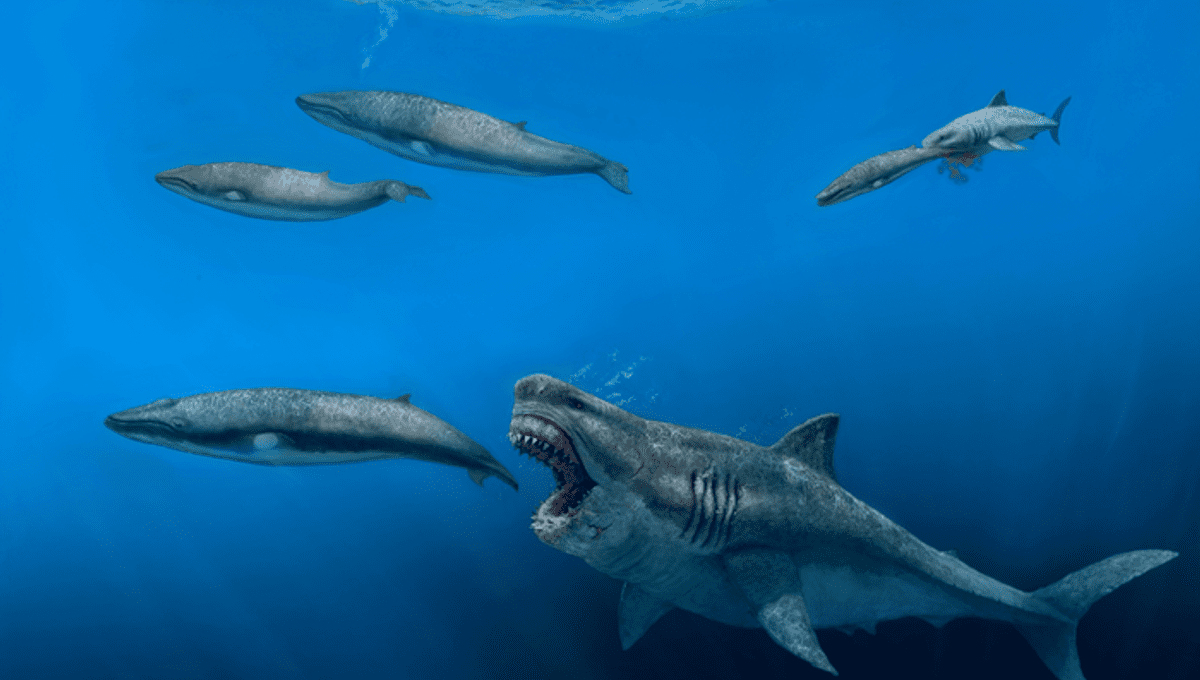
Today’s apex predators would have been a mere snack to a megalodon, according to a new study that suggests the extinct shark could ingest an 8-meter-long (26 feet) marine mammal in just five bites. Based on this finding, the researchers suggest that Otodus megalodon occupied a higher trophic level than great white sharks and other modern predators that like to think of themselves as the top of the food chain.
“We used an exceptionally well-preserved fossil to create the first three-dimensional model of the body of this giant shark and used it to infer its movement and feeding ecology,” write the authors in the journal Science Advances. Because shark skeletons are made of cartilage rather than bone, intact megalodon fossils are extremely rare, and most of what we know about this ancient colossus has been inferred from their leftover teeth.
However, a portion of an 18-million-year-old megalodon vertebral column was miraculously found in Belgium in the 1860s, and was loaned to the study authors by the Royal Belgian Institute for Natural Sciences. After scanning each vertebra, the researchers were able to reconstruct the entire column and reveal that the long-dead animal possessed a spine measuring 11.1 meters (36.4 feet).
A long dead animal indeed.
By combining this reconstructed skeleton with 3D scans of a megalodon skull that was created using the extinct shark’s teeth and other models of great white sharks, the researchers recreated the entire body of the old beastie. In doing so, they determined that this particular specimen was 15.9 meters (52.2 feet) long and weighed 61,560 kilograms (135,716.6 pounds).
Based on these dimensions, the authors “estimate that an adult O. megalodon could cruise at faster absolute speeds than any shark species today and fully consume prey the size of modern apex predators.” More specifically, they calculated the creature’s cruising speed at 1.4 meters per second (3.1 miles per hour) and estimate that it would have needed to consume more than 98,000 kilocalories per day in order to meet its metabolic demands.
With a stomach volume of around 10,000 liters, though, megalodon had plenty of room in the tank to satisfy such an appetite.
“Our prey size and intake results suggest that a [16-meter (52.5-foot) long] O. megalodon could completely ingest, and in as few as five bites, prey as large as O. orca (i.e., 8 meters [26 feet]), a top consumer in modern marine food webs,” write the authors.
In other words, a megalodon could eat a killer whale for breakfast.
Like a full English, though, an orca wasn’t the kind of brekkie you tuck into every day. According to the researchers, consuming one 8-meter-long (26 foot) killer whale would have provided a megalodon with enough energy to keep moving for 63 days without having to eat again. During this time, the shark would have been able to travel 7,500 kilometers (4,660 miles).
“These results suggest that this giant shark was a trans-oceanic super-apex predator,” said study author Professor Catalina Pimiento in a statement. Occupying a higher rung on the food chain than any marine baddie around today, megalodon sought out the largest possible prey in order to fuel their long-distance migrations, with blubbery whales being a particular favorite.
Fortunately for orcas, though, Pimiento says that “the extinction of this iconic giant shark likely impacted global nutrient transport and released large cetaceans from a strong predatory pressure.”
Source Link: Megalodon Could Eat An Orca In Just A Few Bites, 3D Scan Reveals